Following
the success of our Battle of Stamford Bridge game last week Mark & I
decided to refight the lesser known battle of 1066 – The Battle of Fulford
(also known as the Battle of York) . This was actually fought a few days
earlier than Stamford Bridge so in theory we should have started with this one
first.
Our battle of Stamford Bridge can be seen here
Our battle of Stamford Bridge can be seen here
As per my
previous post I have set out the background to this battle in my blog post,
then added the specific rules we have added to this engagement and the orders
of battle and then finally the all action report (AAR).
The core rules used are Hail Caesar
1066 Battle of Fulford
The Battle of Fulford was fought on the outskirts of the
village of Fulford near York in England, on 20 September 1066, when Harald
Hardrada and Tostig Godwinson, his English ally (the King of England's brother), fought and defeated the
Northern Earls Edwin and Morcar.
Tostig was Harold Godwinson's banished brother. He had
allied with King Harald of Norway and possibly Duke William of Normandy.
The English Earls could have hidden behind the walls of York
but instead they met the Viking army outside the city. All day the English
desperately tried to break the Viking shield wall but to no avail.
The battle started with the English meeting the advancing Northmen. On their right flank was the River
Ouse, and on the left was the Fordland, a swampy area, too swampy for an army
to march through.
The Saxons also had a formidable obstacle to their front: a
stream (known as Germany Beck) three metres wide and one metre deep. The Vikings would need to cross this if they were to reach York.
Harald's Viking army approached from the
south.
Initially only Harald and a small portion of his army
arrived at the battlefield facing Morcar and Edwin’s army as most of the Viking force men were still some distance away.Thus for a time the Anglo-Saxon army outnumbered their foe.
Harald lined his army up to oppose the Anglo-Saxons, but he
knew it would take hours for all of his troops to arrive. His least experienced
troops were sent to the right and his best troops hidden in the marsh and trees lining the riverbank.
Morcar and Edwin believed that this was a golden opportunity to
attack but the River Ouse’s tide was then at its highest and the stream in
front of them was flooded.
Unable to advance, Morcar and Edwin were forced to delay
their attack, watching with frustration as more and more of Harald’s troops
began to assemble on the far side of the stream.
Eventually the waters fell and the English struck first, advancing on the Norwegian
army before it could fully deploy.
Morcar's troops pushed the Viking right flank back into the marshlands,
making progress against the weaker section of the Norwegian line. However, this
initial success proved insufficient for victory to the English army, as the
Norwegians brought their better troops to bear upon them, still fresh against
the weakened Anglo-Saxons.
Harald brought more of his troops out from his far left flank to
attack the centre, and sent more men to attack across the marsh by the river. The invaders were
outnumbered, but they kept pushing and shoving the defenders back.
Eventually the Anglo-Saxons
were forced to give ground and were beginning to become enveloped. Within another hour, the men on the beck were
forced off by the Norwegians. Other invading Norwegians, who were still
arriving, found a way to get around the thick fighting and opened a third front
against the Anglo-Saxons on their far left. Outnumbered and outmaneuvered, the Saxons were
defeated. Edwin and Morcar however, managed to survive the fight.
York surrendered to the Norwegians under the promise that
the victors would not force entry to their city, perhaps because Tostig would
not want his capital looted. It was arranged that the various hostages
should be brought in and the Norwegian army retired to Stamford Bridge, 7 miles
(11 km) east of York, to await their arrival.
It has been estimated that at Fulford the Norwegians had
about 10,000 troops of which 8,000 were deployed in the battle, and the
defenders 6,000. During the battle, casualties were heavy on both sides. Some
estimates claim 15% dead. From all accounts, it is clear that the mobilised
power of Mercia and Northumbria was cut to pieces at Fulford.
As you have read from the background this battle was very much one of two halves. The
initial phase belonging to the Saxons with the Vikings finally coming into their
own once the tidal waters of the Ouse had receded and Hardradas forces were
able to perform their flanking attacks.
Historical records are few and far
between for this battle and estimates of the size of forces differ considerably.
We can be pretty certain that the Vikings outnumber the local Saxons and given
their fleet size records suggest that they might have numbered 10,000 warriors.
We can be pretty certain that part of this force was guarding the fleet moored
at Ricall so I have decided the Viking Force will number 8000 men. The Saxon
force will be 75% of this force representing 6000 troops. This would have made this battle equal in size to Hastings.
The Game Setting
In gaming terms the
Vikings will have 16 Warbands at their disposal split into four divisions with
the Saxons having 12 warbands split into three Divisions.
Given the
Saxons caught the Vikings by surprise outside York the full Saxon force will be
on the table at the start of the game.
The Vikings on the other hand will start with two Divisions in the centre of the field, Hardrada's division ‘hidden’ behind the marshland where the beck joins the Ouse and the final 4th Division off table. This is making its way along the east side of the table and will appear randomly at some point in time during the game.
The Vikings on the other hand will start with two Divisions in the centre of the field, Hardrada's division ‘hidden’ behind the marshland where the beck joins the Ouse and the final 4th Division off table. This is making its way along the east side of the table and will appear randomly at some point in time during the game.
Playing
under usual army break rules the Saxon will need to lose(or have shaken 7 units) and
the Vikings 9 units.
The key
feature of the battlefield is the stretch of water known as Germany Beck. This
runs across the battlefield joining the Ouse in the West. Both the main river
and the Beck are tidal preventing troops from crossing when at high tide. The high tide will also affects the marshland to the East and West.
We decided that for the first three turns the Beck would remain uncrossable and the Marsh adjoining the Ouse not fordable until turn 5.
We decided that for the first three turns the Beck would remain uncrossable and the Marsh adjoining the Ouse not fordable until turn 5.
The
following table illustrates this. As you can see the final 4th
Viking Division appears on a random die roll. There is the possibility that
this may not turn up to affect the game. We also agreed that any forces driven
off the table could not return to the fray at a later point in time.
Time/Turn
|
Beck Crossable
|
Marsh Crossable
|
Arrival of Troops (Viking 4th Division)
|
0900hrs
|
No
|
No
|
No
|
09.30hrs
|
No
|
No
|
No
|
10.00hrs
|
Yes
|
No
|
No
|
10.30hrs
|
Yes
|
No
|
No
|
11.00hrs
|
Yes
|
Yes
|
No
|
11.30hrs
|
Yes
|
Yes
|
No
|
12.00hrs
|
Yes
|
Yes
|
No
|
12.30hrs
|
Yes
|
Yes
|
6+
|
13.00hrs
|
Yes
|
Yes
|
6+
|
13.30hrs
|
Yes
|
Yes
|
5+
|
14.00hrs
|
Yes
|
Yes
|
5+
|
14.30hrs
|
Yes
|
Yes
|
4+
|
15.00hrs
|
Yes
|
Yes
|
4+
|
15.30hrs
|
Yes
|
No
|
3+
|
16.00hrs
|
Yes
|
No
|
3+
|
16.30hrs
|
No
|
No
|
3+
|
17.00hrs
|
No
|
No
|
3+
|
17.30hrs
|
High Tide
|
No
|
No
|
Dark
|
If no side has won by 17.30 when it gets dark the battle is assumed to be a draw
Battle of Fulford
(Units)
Saxons
Earl’s Morcar & Edwin (2 x commanders (8)
1 x subcommanders (8)
5 x regular units of Thegns
7 X regular units of Ceorls
6 x Bow Armed Skirmish units
Grouped into three divisions
Break Test 7 units
Deployment – All Saxon Units on the table deployed behind the Germany beck
Vikings
Hardrada & Tostig (8)
2 sub commanders (8)
1 units of Huscarls
8 units Thegns
7 units of Bondi
8 units of bow armed skirmishers
Break Test – 9 units
Grouped into 4 divisions
Deployment
Two Divisions (inc Tostig on the table opposite Saxons)
The other two Divisions are off table at the beginning of the game
One of these is made up exclusively of Hirdmen & Huscarls) – This is Hardradas division. Hardrada division is sitting behind the Marsh – he may opt to send these troops away from their starting location and head to centre of line from turn five (otherwise they sit and wait)
One of these is made up exclusively of Hirdmen & Huscarls) – This is Hardradas division. Hardrada division is sitting behind the Marsh – he may opt to send these troops away from their starting location and head to centre of line from turn five (otherwise they sit and wait)
The fourth division is trying to work it way around the Marsh to the
East – use the following table to denote what happens each turn. Two units of
this division may opt to stay with the main force but will start from base line
Units (using Hail Caesar)
Unit
|
Clash
|
Sustained
|
Short Range
|
Long Range
|
Morale
|
Stamina
|
Special
|
Huscarls
|
7
|
7
|
3
|
0
|
4+
|
6
|
Stubborn
Elite
Tough Fighters
Valiant
|
Heavy Infantry Thegns/Hirdmen
|
7
|
7
|
3
|
0
|
4+
|
6
|
|
Medium Infantry Ceorls/Bondi
|
6
|
6
|
3
|
0
|
5+
|
6
|
|
Light Infantry Geburs
|
5
|
5
|
3
|
0
|
6+
|
6
|
|
Medium Cavalry Thegns
(small unit)
|
6
|
3
|
2
|
0
|
5+
|
4
|
|
Skirmishers/Thralls with javelins(small unit)
|
3
|
2
|
2
|
0
|
0
|
4
|
|
Skirmishers with Bows(small unit)
|
2
|
2
|
2
|
2
|
0
|
4
|
|
Skirmishers with Slings(small unit)
|
2
|
2
|
2
|
2
|
0
|
4
|
|
Light Infantry Bondi with Bows
(small units)
|
3
|
3
|
2
|
2
|
6+
|
4
|
Stubborn: Reroll one failed morale save
Elite; Recover from disorder on 4+
Tough Fighters: Reroll one missed HTH combat roll
Valiant: Breaktest
reroll once per battle
Our Game
We diced
for sides given that this a new game and had no idea how it would play out.
Had there of been an uneven number of players I would have umpired and not disclosed when the waters might fall and informed the Saxon commander that more Vikings could be expected to appear (but not from where)
In the end I commanded the Saxons, Mark the Vikings.
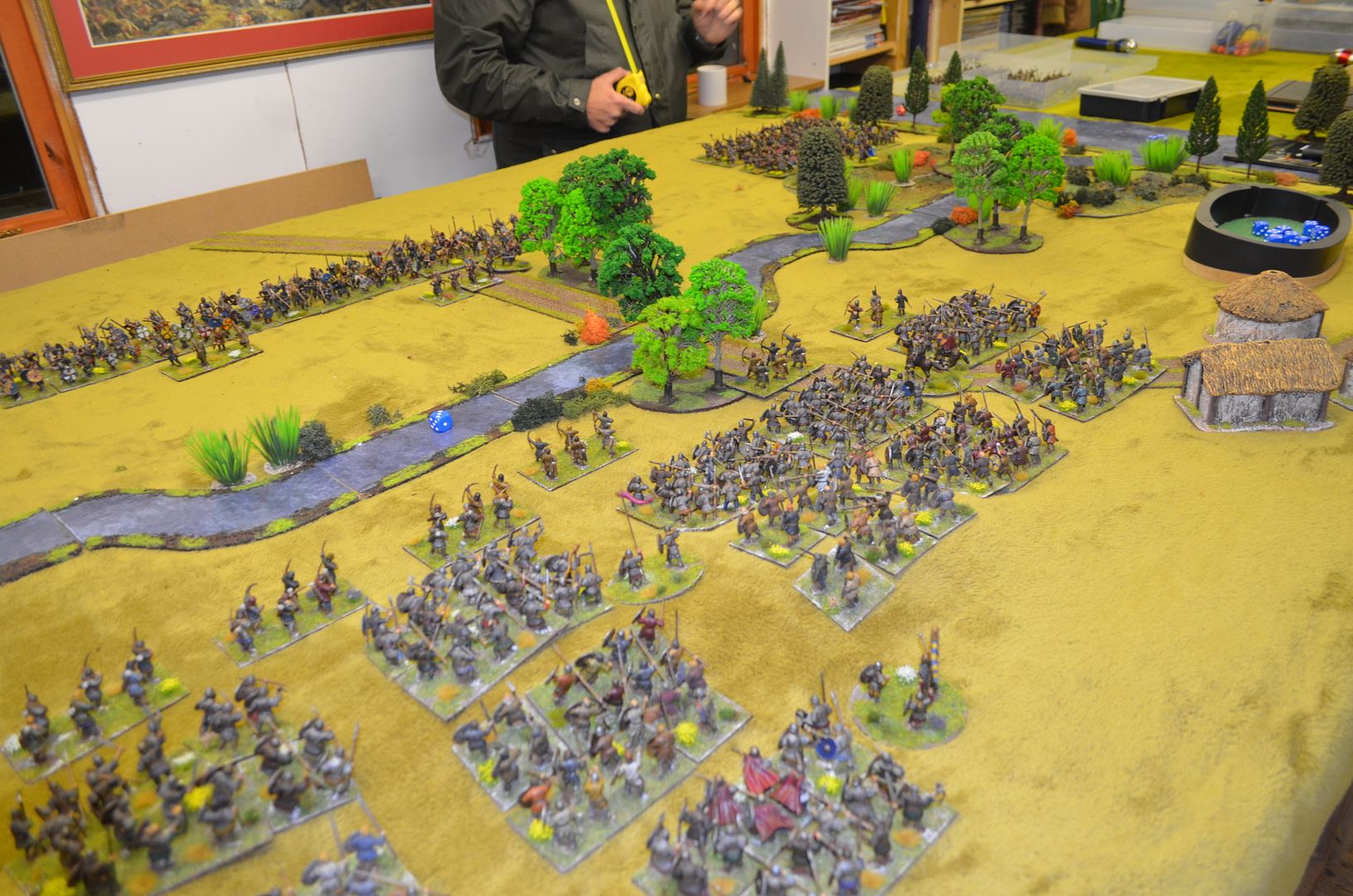 |
| The Saxons (foreground facing a few Vikings over the Beck) - the river is in the distance on the right |
It was apparent from the Saxon perspective that to win this game I had to take on the Vikings quickly before their reinforcements arrived and enveloped my flanks.
My left division pushed forward upto the beck.
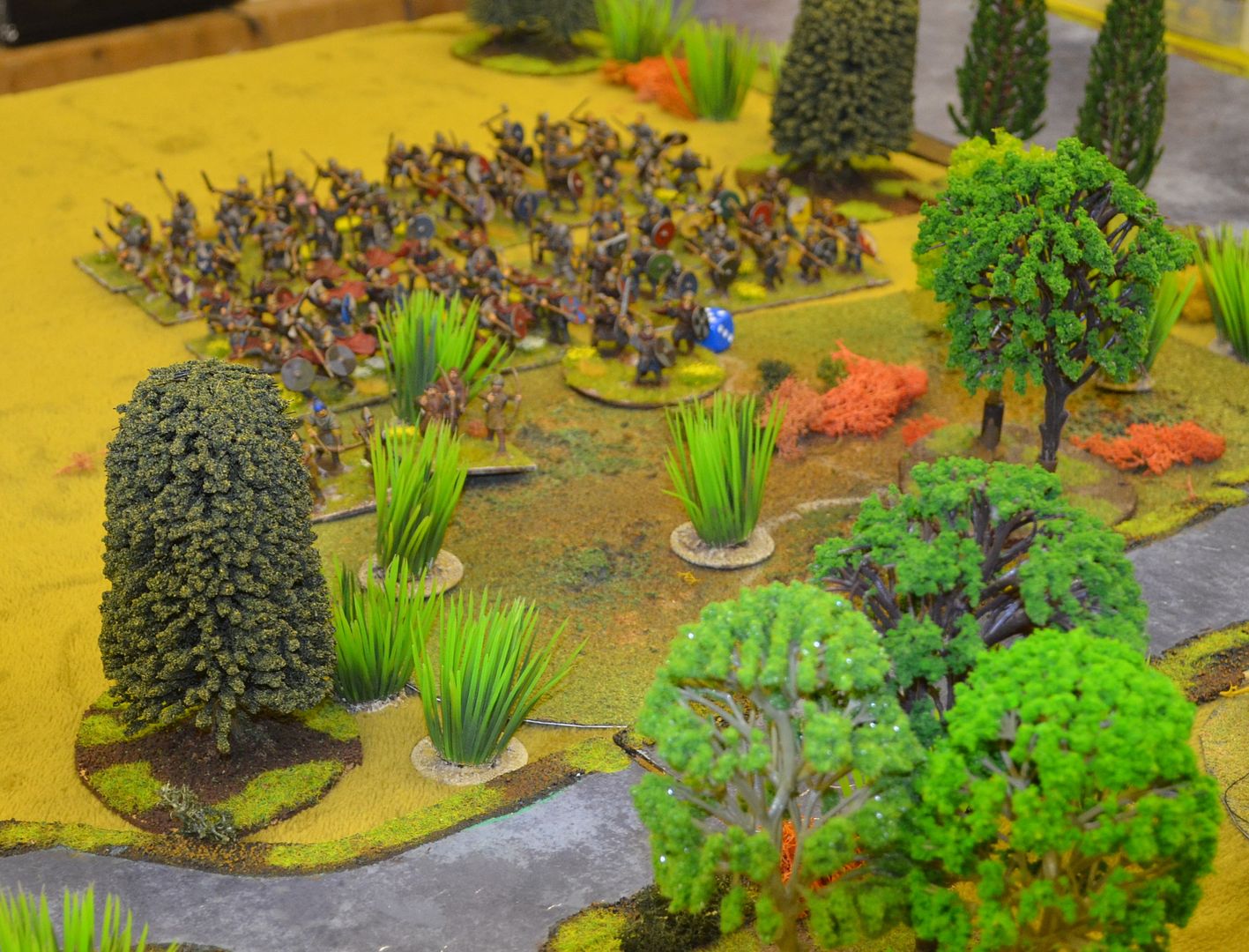 |
| Hardrada's hidden troops |
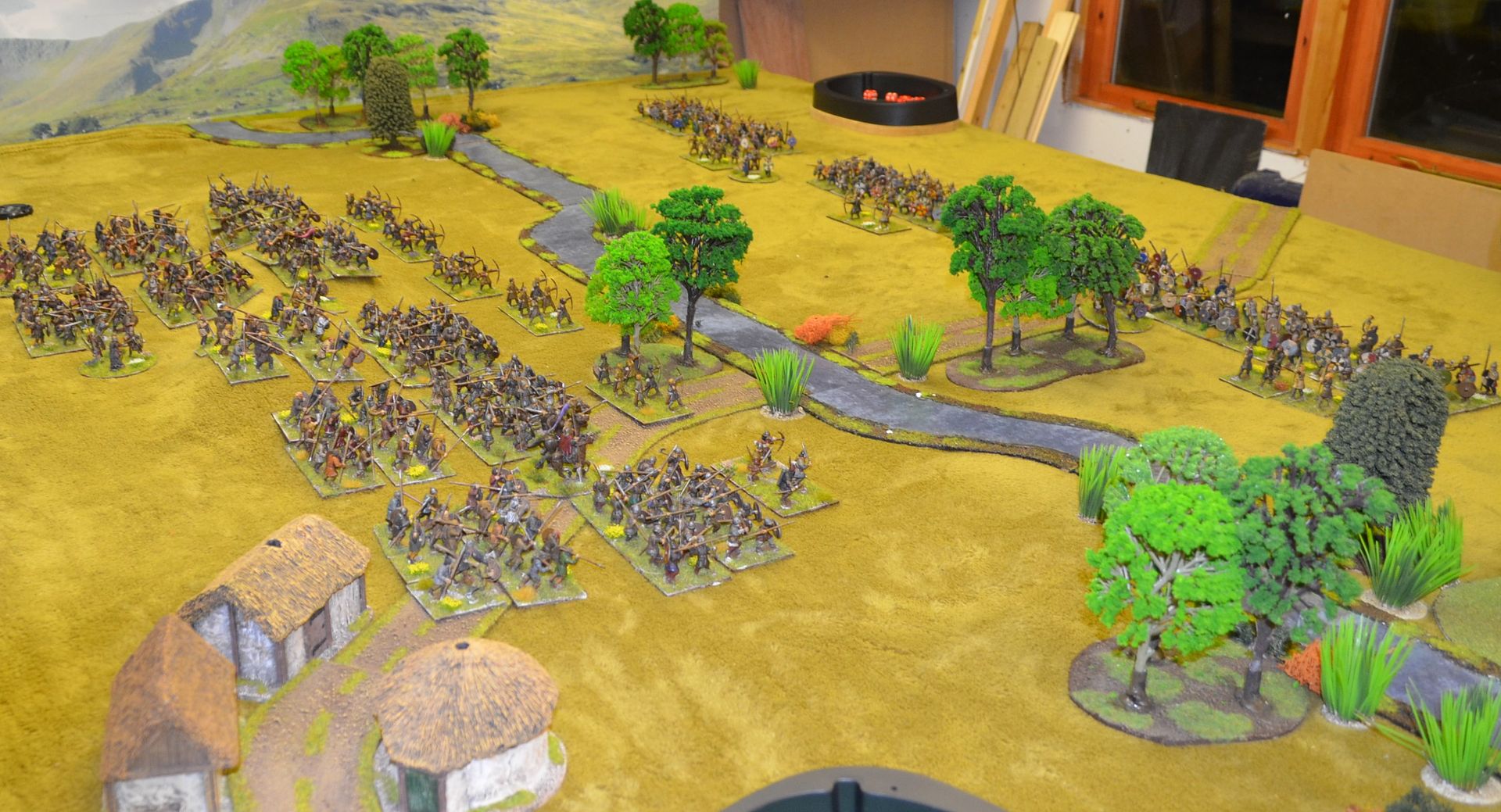 |
| The Saxons push forward |
Once at the Beck I had to wait for the waters to fall (another turn at least)
Now in range my skirmish units opened fire at long range successfully driving back their opposite number.
army.
Fearing that his on table divisions were going to get peppered full of arrows the Viking forces stepped backwards and formed up in shield wall.
With the Waters falling my forces were set to surge forward.
Morcar's left Division crossed the Beck and advanced onto the Viking far right flank.
Morcar's other division (in the Saxon centre then blundered, retreating a full two moves. This Division then ceased to roll any successful commands for the whole game. Effectively a third of the Saxon force had just decided they didn't want to play ball.
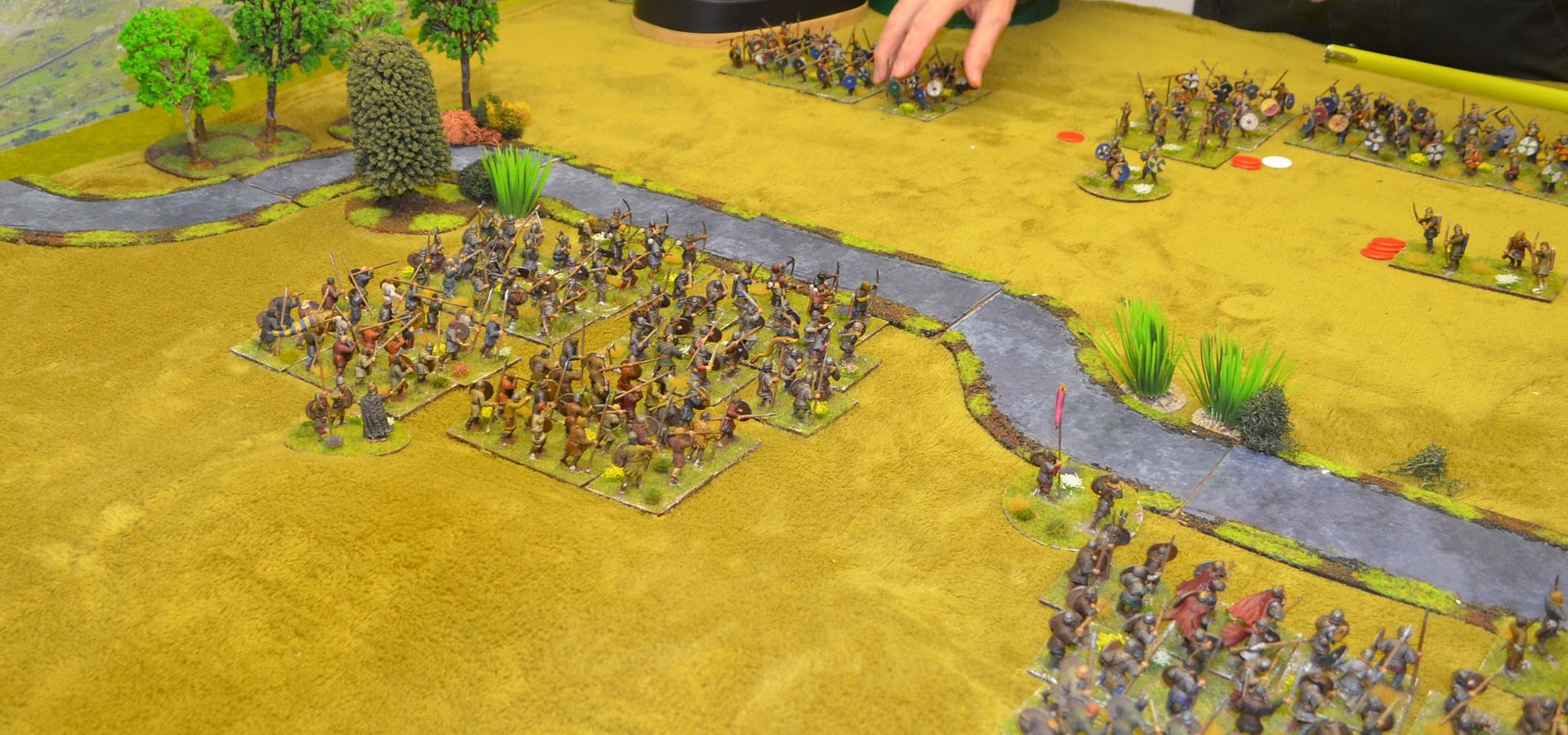 |
| About to cross the Beck (saxon left flank) |
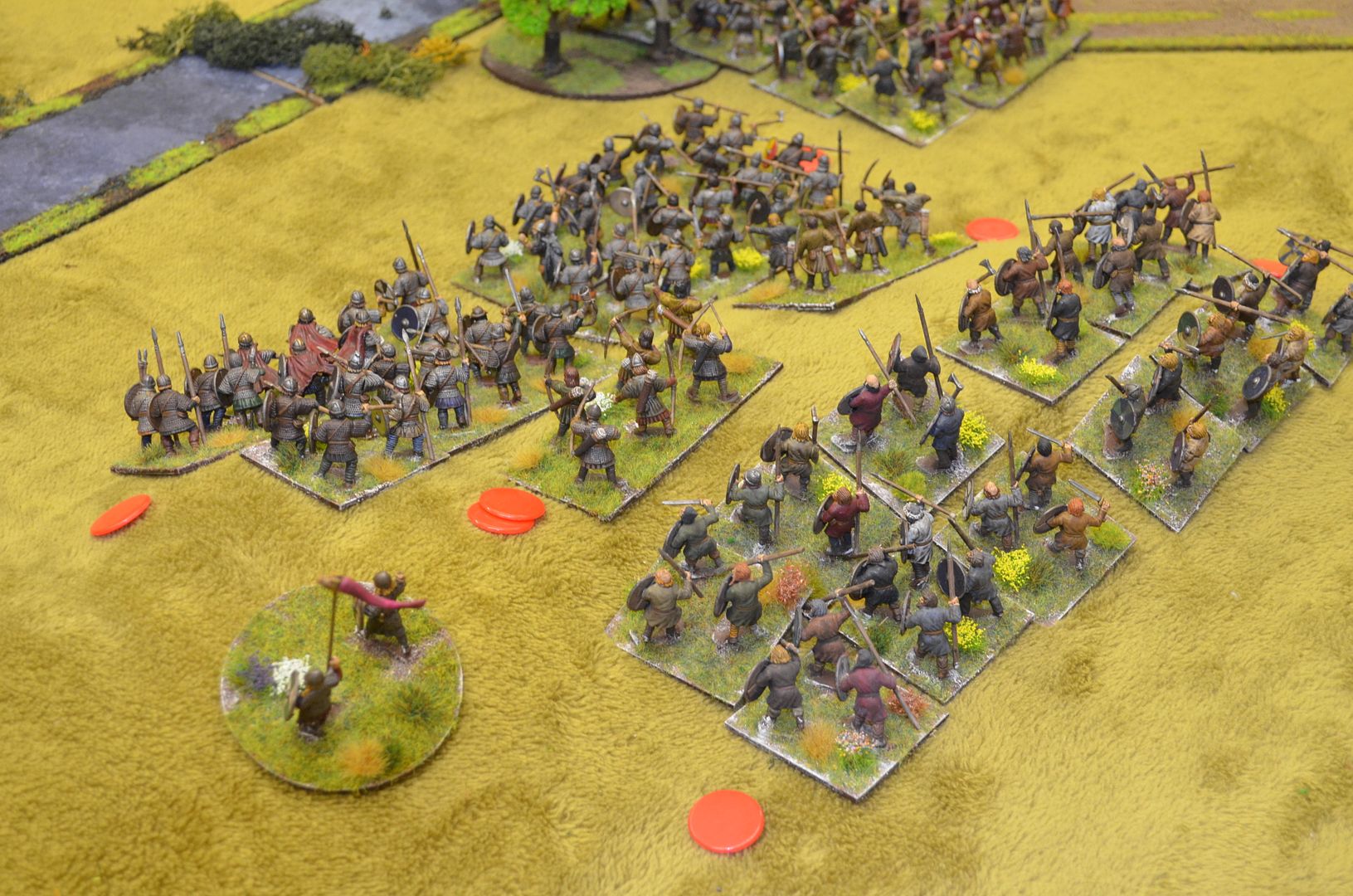 |
| The 'blundered' - a lot of forces |
By turn 4 the left flank of the Saxons had crashed into the Viking line and inflicted some serrious casualties for little cost of their own.
Within a turn one Viking division had been driven from the table. Their own troops blundering a causing disorder in the ranks helped.
By the time we reached turn five the Saxons were still inflicting serious casualties on the Viking right flank but my attack had stalled elsewhere with little or no movement happening in the rest of the army. It was at this point that Hardrada's own troops entered the fray
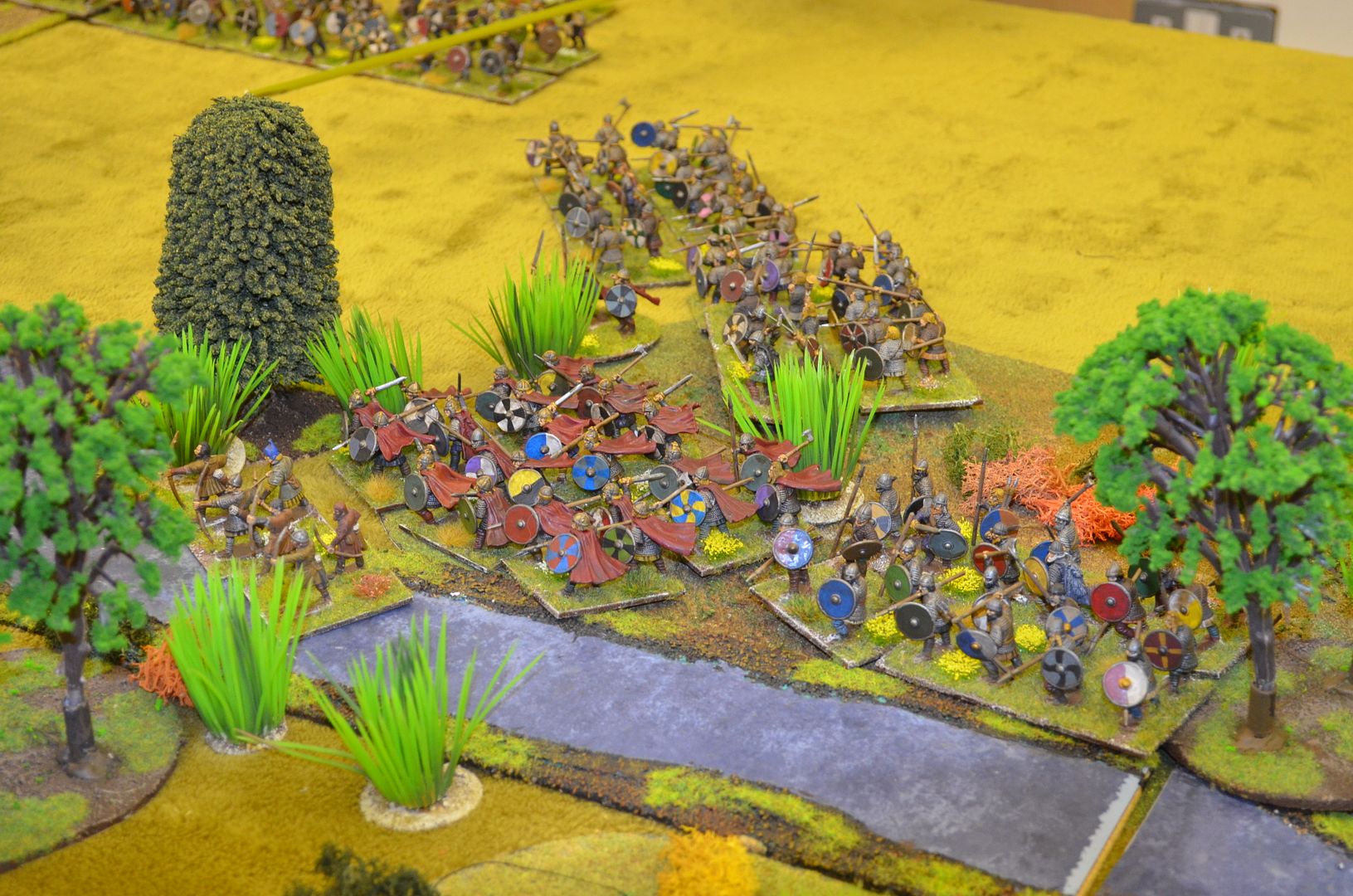 |
| Hardrada's men crossing the marsh |
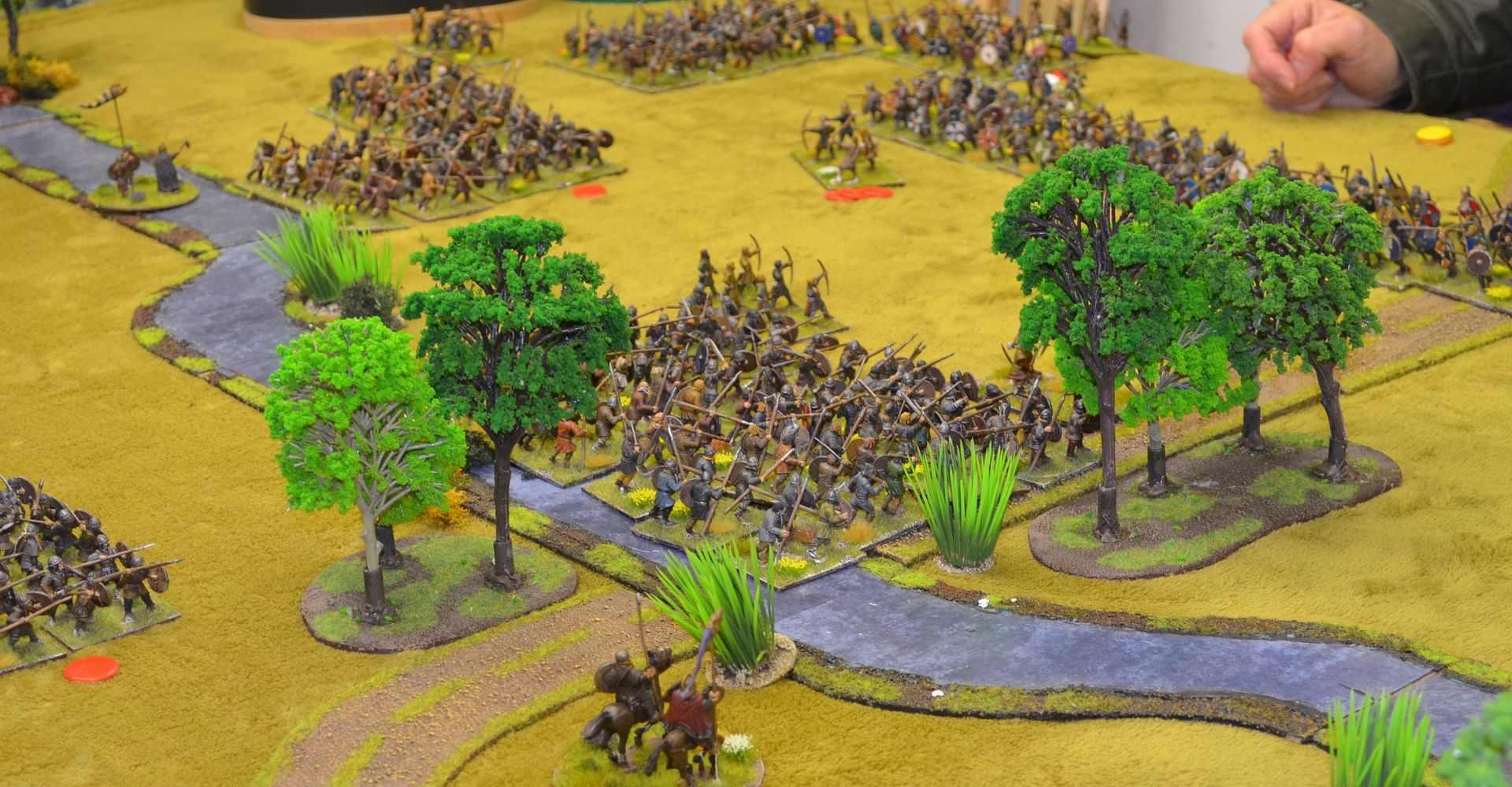 |
| The Stalled Saxon Centre |
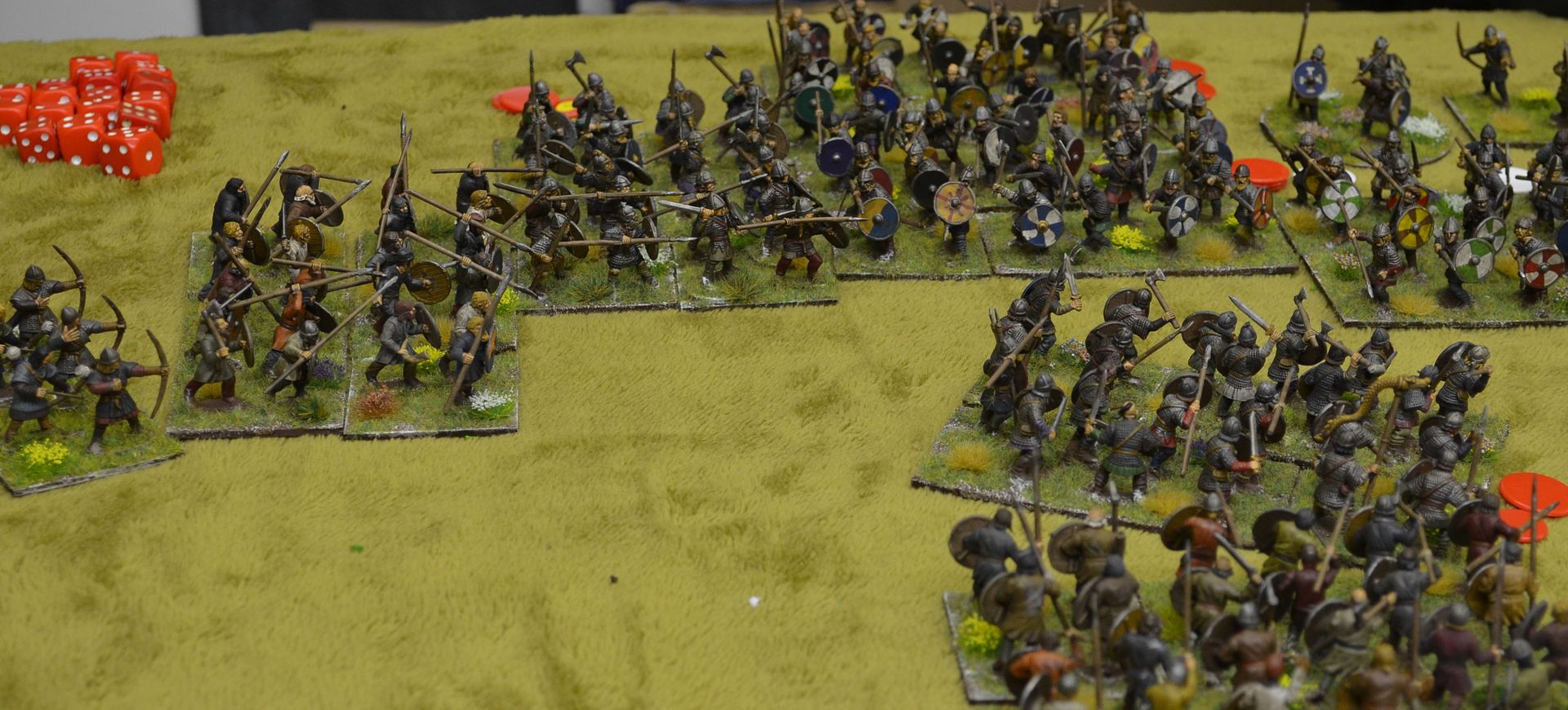 |
| The Saxons rolling up the Viking flank |
Watched by my division sitting on the hill (still hadn't moved) Hardradas forces crashed into my centre - wiping out two units in quick succession
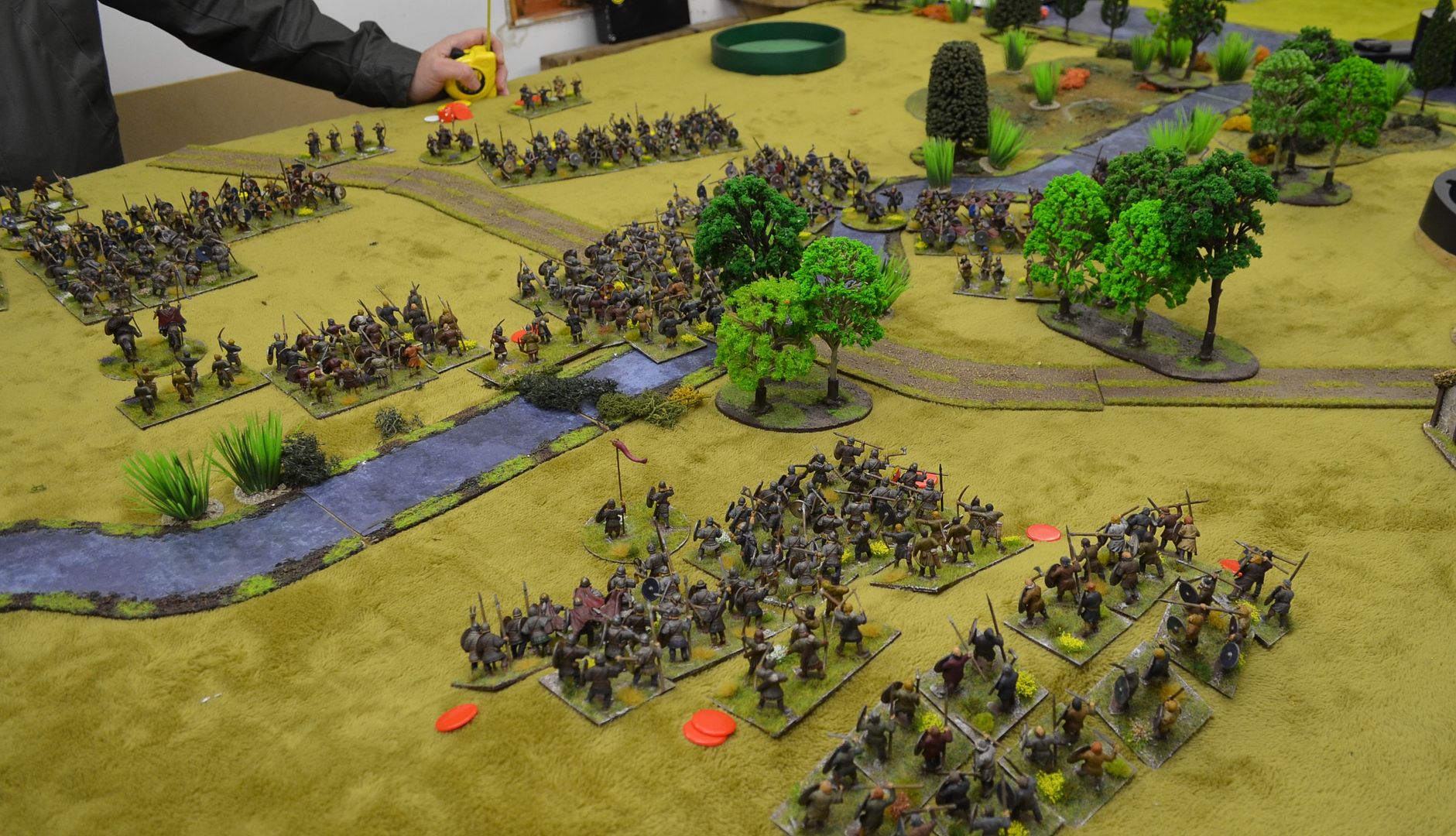 |
| The battle in full flow - a fierce melee across the field |
The Saxon assault on the left was now running out of steam (and troops) and the Vikings were slowly taking back the initiative. Both sides had lost five units but the better break values of the Northmen was likely to tell. Especially given that they had another fresh division still to enter the fray.
A turn l;ater Mark had all but achieved his objectives and the Vikings could be crowned winners.
Despite the fact that the Saxons had a third of the forces out of the whole game they had acquited themselves well. Had the third division been involved and if I had not forgotten to use my initiative there was a reasonable chance the Saxons might have pulled off an unexpected victory.
This was an interesting game and one we might revisit in the future
thank you...
up next the big one - Hastings !!
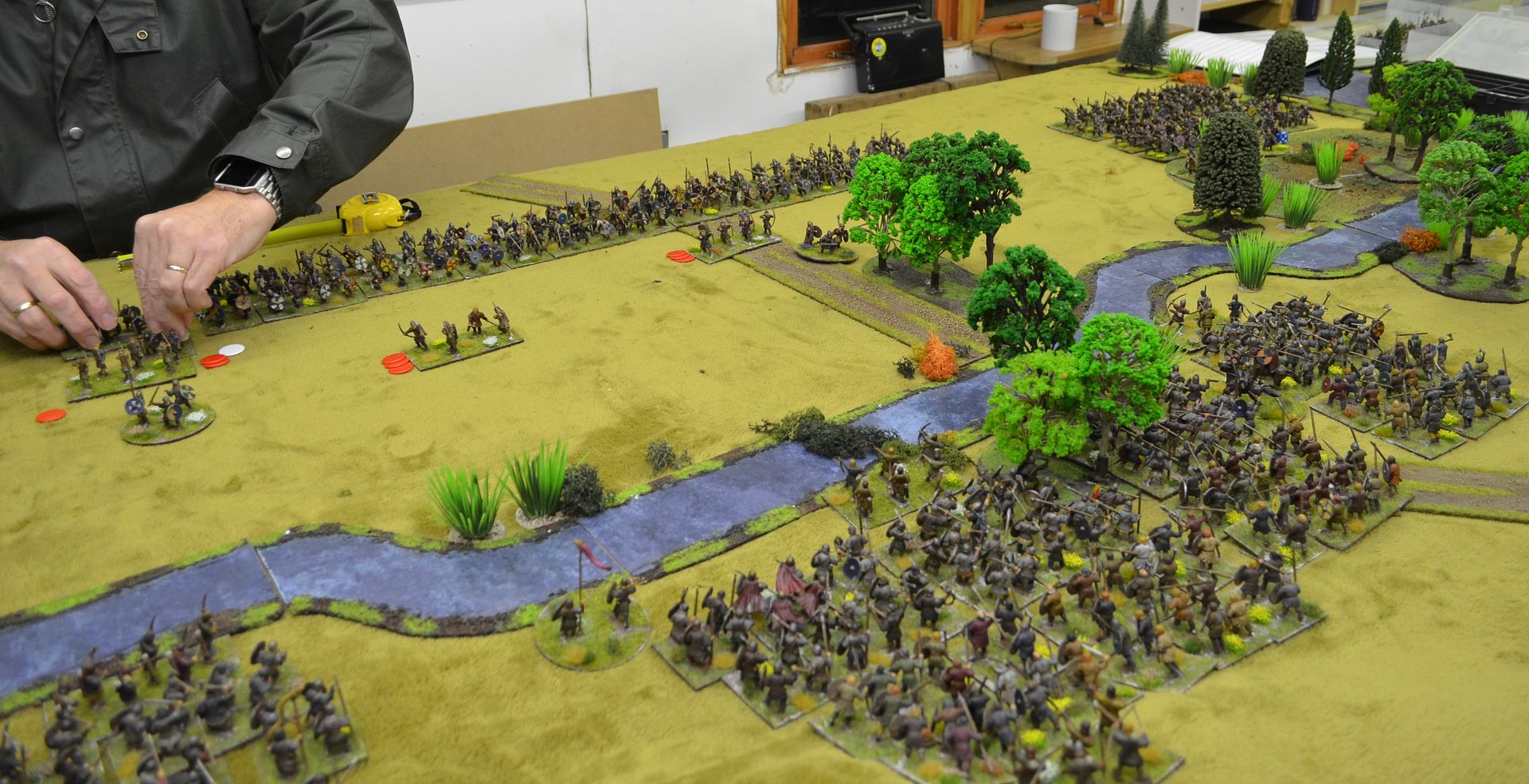
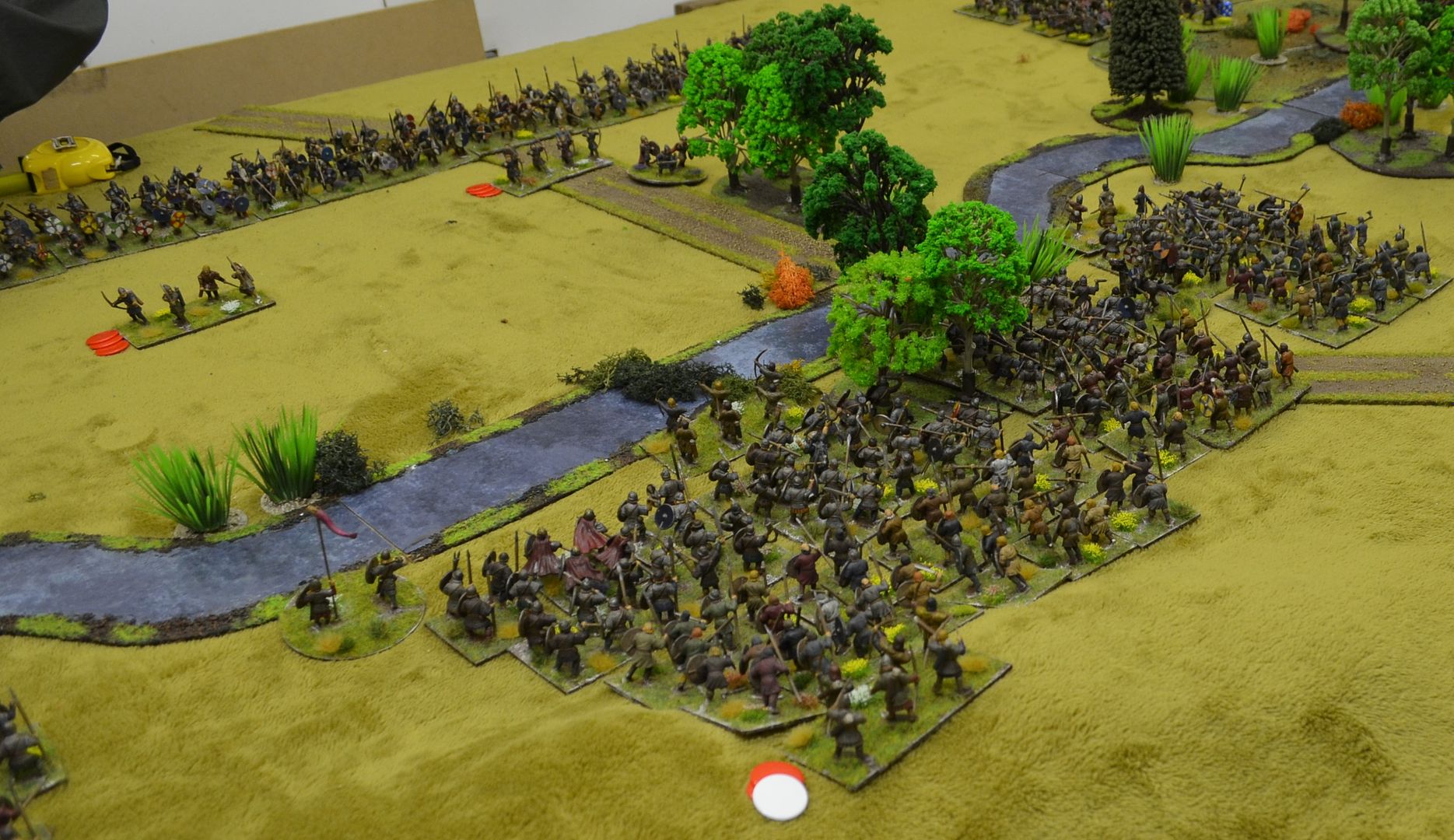
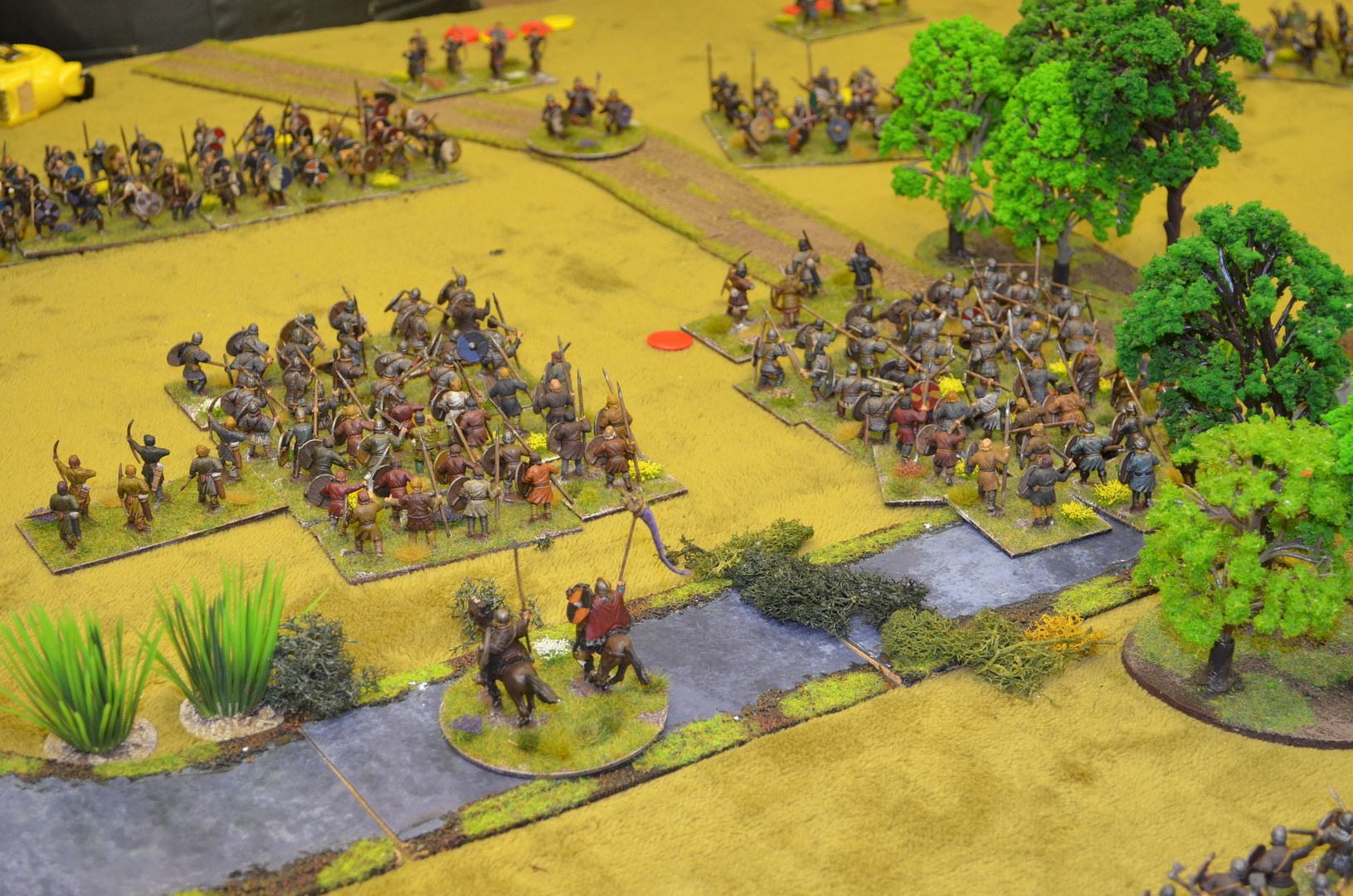
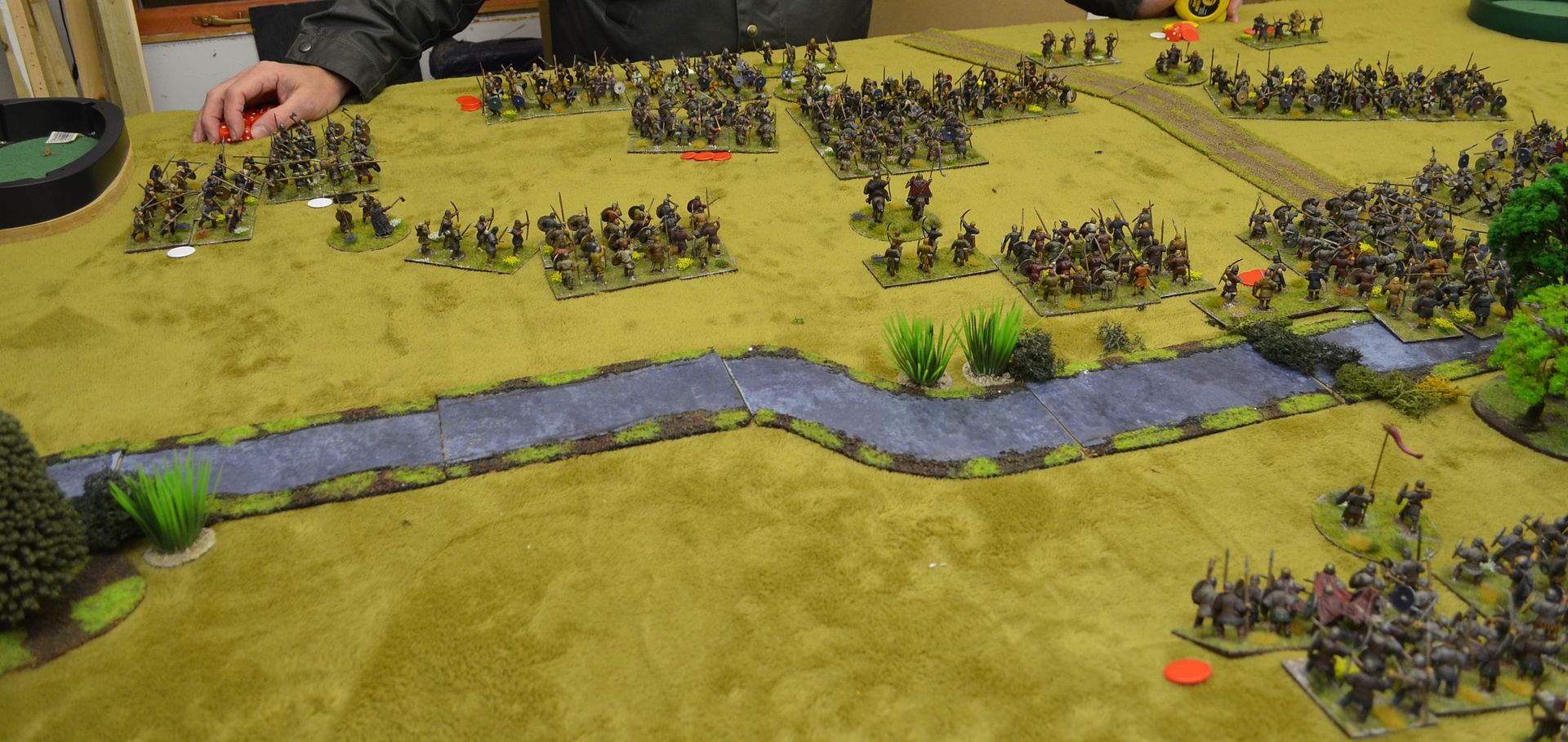

Starks always beat Greyjoys ... :-)
ReplyDeleteVery cool. Love the masses of troops. Great job!
ReplyDeleteA historical result, but a great what-if moment.
ReplyDeleteGreat write up mate, thank you.
ReplyDeleteGreat to see the figures out in a large scale game 🙂
ReplyDeleteGreat AAR. I really like the waters receding as part of the scenario. This scenario looks like a winner. 😀
ReplyDelete